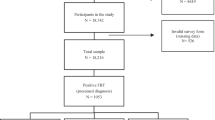Summary
Several studies advocate quantification of the bending test or performing surface topography to reduce the referral rate and to increase the specificity of the bending test in screening for scoliosis. Within the framework of a school screening project all children with a positive bending test were reexamined with measurement of rib hump height, angle of trunk rotation and moiré topography. In the period 1983–1986, out of three cohorts of 10 000 children of 10, 12 and 14 years of age, 3069 were reexamined, of whom 1931 again tested positive (63%). The value of the three techniques in terms of sensitivity and specificity within the reexamined group was evaluated with regard to the Cobb angle on a spinal radiograph, which was made in 671 cases. A reduction in referrals of 37% was found. No significant difference in the ability to detect scoliosis was found between the three techniques mentioned. It is concluded that measurement techniques are valuable in school screening programmes. In particular, if instead of a single cut-off value, a range within which the examination should be repeated is chosen, high sensitivity and high specificity can be combined. Angle of trunk rotation measurement seems to be the easiest method of screening.
Similar content being viewed by others
References
Adair IV, Wijk MC van, Armstrong WD (1977) Moiré topography in scoliosis screening. Clin Orthop 129:165–171
Asher M, Beringer GB, Orrick J, Halverhout N (1989) The current status of scoliosis screening in North America, 1986. Results of a survey by mailed questionnaire. Spine 14:652–662
Ashworth MA, Ersil AK (1981) The measurement of rib hump inclination — a potential aid in scoliosis screening. Scol Res Soc 5:33–34
Bunnell WP (1984) An objective criterion for scoliosis screening. J Bone Joint Surg [Am] 66:1381–1387
Hearn M, Crowe A, Keessen W (1989) Influence of age on proprioceptive accuracy in two dimensions. Percept Mot Skills 69:811–818
Laulund T, Syjbjerg JO, Hyrlyck E (1982) Moiré topography is school screening for structural scoliosis. Acta Orthop Scand 53:765–768
Lonstein JE (1988) Natural history and school screening for scoliosis. Orthop Clin North Am 19:227–237
Nachemson A (1989) School screening for scoliosis (letter). Acta Orthop Scand 60:124
Ohtsuka Y, Yamagata M, Arai S, Kitahara H, Minami S (1988) School screening for scoliosis by the Chiba University Medical School: screening program. Results of 1.24 million students. Spine 13:1251–1257
Ponte A (1982) Prognostic evaluation of vertebral rotation in small idiopathic curves. Proceedings of the Scoliosis Research Society, Denver, Colo. 20: 46–47
Pruijs JEH, Keessen W, Meer R van der, Wieringen JC van, Hageman MAPE (1992) School screening for scoliosis: methodological considerations. 1. External measurements. Spine 17:431–436
Pruijs JEH, Hageman MAPE, Keessen W, Meer R van der, Wieringen JC van (1994) Variation in Cobb angle measurements in scoliosis. Skeletal Radiol 23:517–520
Schulthess W (1902) Über die Lehre des Zusammenhanges der physiologischen Torsion der Wirbelsäule mit lateraler Biegung und ihre Beziehungen zur Skoliose. Z Orthop 10:455–494
Stokes IAF, Moreland MS (1987) Measurement of the shape of the surface of the back in patients with scoliosis. J Bone Joint Surg [Am] 69:203–211
Stuurmans F (1984) Epidemiologie, theorie, methoden en toepassing. Dekker en van de Vegt, Nijmegen
Swets JA, Pickett RM (1982) Evaluation of diagnostic systems: methods from signal detection theory. Academic Press, New York
Thulbourne T, Gillespie R (1976) The ribhump in idiopathic scoliosis measurement, analysis and response to treatment. J Bone Joint Surg [Br] 58:64–71
Vercauteren M, Beneden M van, Verplaetse R, Croene Ph, Uyttendaele D, Verdonk R (1982) Trunk asymmetries in a Belgian school population. Spine 7:555–562
Vinchon B (1965) Présentation d'un appareil permettant la mesure des gibbosités coliostiques. Rev Chir Orthop 51:643–644
Wijk MC van (1980) Moiré contourgraph — an accuracy analysis. J Biomech 13:605–613
Williams JI (1988) Criteria for screening: are the effects predictable? Spine 13:1178–1186
Willner S (1979) Moiré topography for the diagnosis and documentation of scoliosis. Acta Orthop Scand 50:295–302
Willner S, Udén A (1982) A prospective prevalence study of scoliosis in southern Sweden. Acta Orthop Scand 53:233–237
Author information
Authors and Affiliations
Additional information
We regret to inform the reader of the death of W. Keessen on 4 December 1993.
Rights and permissions
About this article
Cite this article
Pruijs, J.E.H., Keessen, W., van der Meer, R. et al. School screening for scoliosis: the value of quantitative measurement. Eur Spine J 4, 226–230 (1995). https://doi.org/10.1007/BF00303416
Received:
Revised:
Accepted:
Issue Date:
DOI: https://doi.org/10.1007/BF00303416




